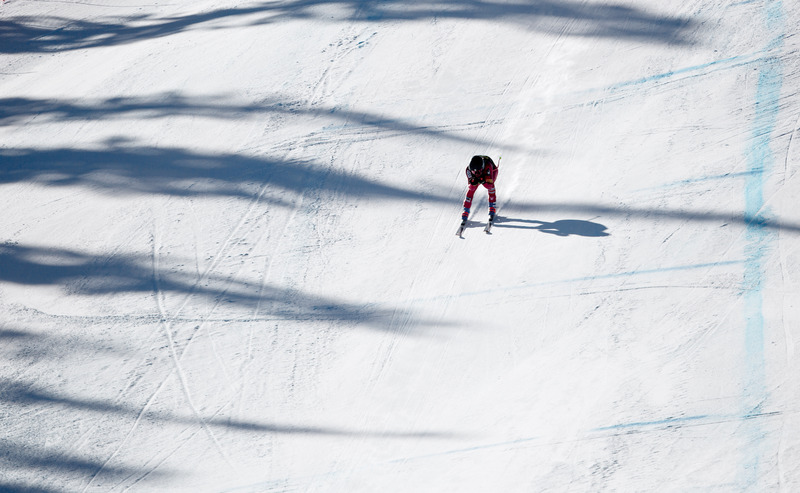The Local newsletter is your free, daily guide to life in Colorado. For locals, by locals.
Many of the world’s fastest skiers descended on Colorado for their Olympic-season preparation this fall. Because of its elevation, premiere snowmaking capability, and the length of its course, Copper Mountain’s U.S. Ski Team Speed Center is one of the only places on the globe where skiers can train at maximum speed before the downhill racing season begins, and the Centennial State is one of the few places where conditions—dry, grippy snow—resemble what skiers will face at the Olympics in South Korea.
National teams from Norway, Sweden, Germany, Austria, Italy, Canada, and Japan have been training at Copper over the past few weeks. But U.S. Team skiers, in particular, are hoping the Colorado training provides some specialized work for the Olympic speed events, especially considering that a couple of the top American athletes are coming back from injury. In November, we caught up with a few American Olympic hopefuls between their training runs at Copper.

Travis Ganong, last season’s top-ranked American male speed skier, sustained a bone bruise in a bad landing during the test race on the Olympic hill two years ago and is determined—with the help of his training block at Copper—to master it in February.
“The track in South Korea is kind of its own thing. It’s a little similar to here because it’s flowy and not super challenging,” Ganong says. “There aren’t a lot of places where you can separate yourself technically. It’s definitely a gliding course. It’s about how you manage the terrain, landing off the jumps in the right spot to carry speed. The snow is really similar to here in Colorado. It doesn’t get icy. It’s dry and grippy.”
Ganong’s teammate Steven Nyman, a veteran who posted the best American showing in the downhill test race in South Korea two years ago, suffered a season-ending knee injury last January and is trying to regain form in time to race on a familiar Olympic course in Jeongseon. “The [South Korean] course has a lot of step-downs and jumps. You have to be tactically clever and you have to be able to adjust to the terrain. I like it. I like the hill,” he says. Still, he’s unsure if he’ll be able to overcome his injury and make it to the podium in South Korea. “Everyone I talked to says you don’t feel good until about a year out, and that’s right before the Olympics.”
Both men will race this weekend at Beaver Creek, the only regular U.S. stop on the men’s World Cup alpine circuit—a race where Nyman has landed on the podium three times throughout his career.
Several American women are also coming back from injury this season. Like Nyman, Laurenne Ross tore knee ligaments in a crash last season, but her injury—tearing pretty much all of the ligaments in her right knee as well as the meniscus—came at the end of March and she’s been pushing to make a full recovery for 2018 Winter Games in February. “This is by far the worst injury I’ve ever had,” says Ross, who during her ski racing career has also shattered her pelvis, torn ligaments in her left knee, broken numerous fingers and severely lacerated her face. “It was so much more painful, so much more work to come back from.”
When the women’s World Cup made its inaugural stop at the Olympic venue in Jeongseon last season, Ross put her stamp on the place. While Lindsey Vonn garnered the top American result, Ross was not far behind. Ross took fourth in the downhill and sixth in the super G. And despite her injury, she believes she can succeed in South Korea. “I know I can do well there. I know I can be fast on that hill,” Ross says. “I’m just trying to be present, I’m trying to be here right now. I’m focusing on my training…If I get too far ahead, I won’t be able to execute my plan.”
Having undergone surgery in Vail in April, Ross is pushing protocol in order to prep for the Olympics. “[My doctor] said it would normally be nine months [to return to on-snow training],” she says. “With my goals in mind, this being what it is with the Olympics coming, he was surprised by my progress. I’m pushing the limits.”
Stacey Cook, another veteran on the U.S. speed team, trails Vonn and Ross in the women’s downhill and super G standings, but she also had breakout results in last season’s Olympic test races in South Korea, finishing sixth in the downhill race, less than a half-second away from the podium. “I loved that course from the first inspection,” she says. “It felt like a true downhill.” She echoes the sentiments of her teammates in that this final block of speed training in Colorado is especially useful preparation for the Olympics. “It’s cold, grippy snow here, very dry, very similar to what they have in South Korea,” Cook says. “The compact, grippy snow is something that plays to the talent and skill set of North Americans.”








